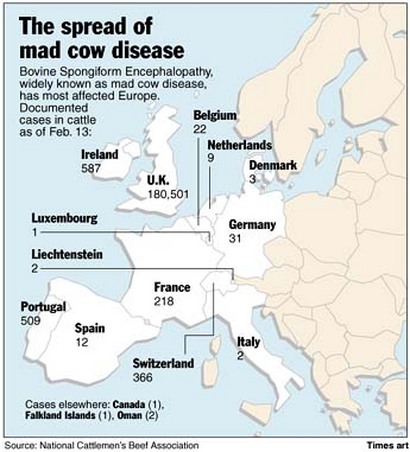What is Mad Cow Disease?

Mad Cow Disease, (bovine spongiform encephalopathy) is a neurodegenerative disease in cattle. It causes a sponge like degeneration of the brain and spinal cord. Its incubation period could last from 2 years to 8 years. The infectious agent in BSE is believed to be a prion. A prion is made up of a protein folded in a misfolded form. Cattle get this disease from eating infected sheep. Cow's may be grazing animals, but they are fed protein supplements from other animal sources.
Around 200,000 of infected cattle cases have been reported. Over 180,000 of them were in the United Kingdom.BSE has been reported in 11 North American cattle, 10 born here and one imported from the UK. The first native case was an Alberta, Canada, beef cow reported in May 2003. Canada has since reported six more cases, most recently in July 2006 in a 50- month-old dairy cow in Manitoba. The first U.S. case was in a Canadian-born dairy cow found in Washington state in December 2003. The other two U.S. cases were a 12-year- old Texas-born and -raised beef cow, found in November 2004 but not confirmed until June 2005, and a 10-year-old Alabama beef cow found in late February 2006.
This disease is rarely ever spread to humans because the cow meat that is sent to the supermarkets does not contain the disease. The disease only affects the brain and the spinal cord. Neither of those parts are used as meat to eat. There have been some reported cases that some people have had a human form of this disease but this disease is too rare to ever become an epidemic.
Around 200,000 of infected cattle cases have been reported. Over 180,000 of them were in the United Kingdom.BSE has been reported in 11 North American cattle, 10 born here and one imported from the UK. The first native case was an Alberta, Canada, beef cow reported in May 2003. Canada has since reported six more cases, most recently in July 2006 in a 50- month-old dairy cow in Manitoba. The first U.S. case was in a Canadian-born dairy cow found in Washington state in December 2003. The other two U.S. cases were a 12-year- old Texas-born and -raised beef cow, found in November 2004 but not confirmed until June 2005, and a 10-year-old Alabama beef cow found in late February 2006.
This disease is rarely ever spread to humans because the cow meat that is sent to the supermarkets does not contain the disease. The disease only affects the brain and the spinal cord. Neither of those parts are used as meat to eat. There have been some reported cases that some people have had a human form of this disease but this disease is too rare to ever become an epidemic.
